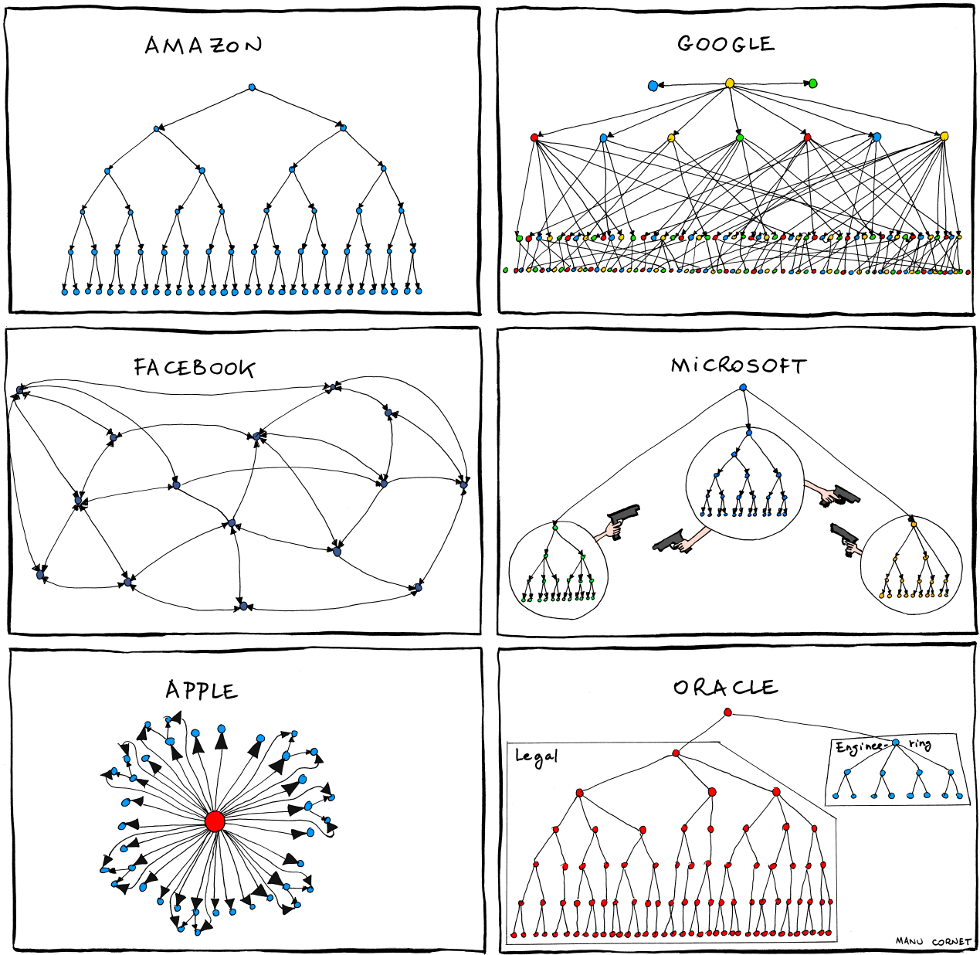I originally posted this on my company’s blog, but the website has been under repair. In the meantime, I thought I’d re-post it here.
The original addendum post can be found here.
I recently learned about Holacracy, a new organizational model for businesses that has been getting a lot of public recognition. My boss sent me an article on it because I’m fascinated by how organizations work (and don’t work) on the inside in order to interact in a productive manner with the outside.
There are many organizational models as well as many solutions for the inevitable problems that arise from those models, particularly when applied outside of their ideal setting. We humans, being inherently imperfect, may never create the perfect system, but we work hard trying to find the best one possible or, at a minimum, make the best of the one in which we find ourselves.
Three Standard Organizational Models
While many organizational systems have been theorized, many of those fit into one of these categories:
Democracy (Consensus decision-making by those being governed)
Bureaucracy (Consensus decision-making by those not being governed)
Hierarchy (Centralized decision-making by those not being governed)
Much as I would love to go into depth describing how these systems work and how they differ, let us assume that you already know a little about all of them and get on to holacracy.
The Subject Model: Holacracy
Holacracy is centralized decision-making by those being governed. It appears to be the anti-bureaucracy, anti-hierarchy. In contrast to other models, it is largely flat and egalitarian. Rather than being governed by an untouchable collective or demanding the agreement of disparate groups and individuals with often conflicting motivations, each small group within an organization governs itself, free to make decisions that affect the whole based on a common mission.
If you have some time to watch (or at least listen), these videos are lengthy but informative. The first is a Holacracy presentation/lecture by Frédéric Laloux, author of Reinventing Organizations. It’s less about mechanics and more about theory but it approaches holacracy in terms of humanity’s cultural evolution.
This second video is a talk on the emergence of intelligent behavior in undirected social structures in nature. I found this talk to be an excellent (though quite unintentional) exploration of the principles of holacracy.
If you don’t have much time (like most of us), this short video will give you a general idea of how holacracy works.
I’d like to address many of the points made in these videos, but this is a blog post, not a thesis and I’m already running long. Instead, let’s have a look at some examples.
Examples
Zappos and other highly successful, complex customer-interactive enterprises have boldly adopted holacracy as a business model. It was this article about Tony Hsieh, the CEO of Zappos, that Mike sent me (with the statement, “Enjoy, your brain will melt if you aren’t familiar with Tony Hsieh.”) that brought holacracy to my attention.
Inside Zappos CEO Tony Hsieh’s radical management experiment that prompted 14% of employees to quit
Secondly, many organisms in nature are non-hierarchical. Colonial organisms are essentially collections of individual organisms that work together. Common examples include social bee and ant colonies, but jellyfish and pyrosomes are as well. Indeed, if you were to look closely at nature, you would find countless examples of just about every organizational model imaginable. Look some of them up (when you’re finished this, of course). I don’t expect you’ll do anything else for at least half an hour once you’ve started.
Lastly, asymmetrical tactics are practiced by guerrilla forces, terrorists, and our special forces, possible only because they operate as largely independent cells guided by a mission and supported by a larger organization. This same principle of small groups coordinating without direction has played a role in everything from flash mobs to the Arab Spring.
The examples I present show places where not being directed is an advantage to the organization. I could pull up as many examples where the opposite is true. Problems such as those for which holacracy was created to address are not only common but also classical and compel people to create bold new solutions.
Me and Holacracy
I am a hypocrite if I claim that I am not intrigued and excited by the possibility of holacracy. It’s hard not to be excited by the sentence, “Power is no longer in limited supply.” I really like that statement in that it points out that, in classical hierarchy, power is in limited supply and thus centrally located. Rather, in holacracy, power is decentralized as it is in military distributed operations; by necessity.
The system is intuitively ideal for me, but I recognize that this is not so for everyone. While I think that a lot of us Americans could use some growing up (as Laloux suggested), I don’t think that we are culturally unwilling to own our lives (as would be necessary in holacracy), particularly in the workplace. Indeed, I think that particular trait is one of the characteristics that defines our national culture.
Therein I begin to take issue with some aspects of the system. Holacracy, to continue in that blue vein, is presented as an evolutionary progression without noting that evolution is not tantamount to ascension but simply change to suit changes in the environment. If there were characteristics of pre-modern organizational systems that could solve problems today, it would be irresponsible not to incorporate them into our present model. I see holacracy as an option, as one solution for a particular kind of organizational need, not the end solution to all organizations.
I also disagree with the notion that, “There is no cell that is in command.” I acknowledge that there is no one brain cell in your head that runs the whole show; no one cell that is you. But there are regions of your brain more in control than others; more core than others. At a certain complexity it becomes necessary to redefine the boundaries of the basic unit. Perhaps neither a single person nor a single cell controls everything, but certainly a group of them do.
Hierarchy did not arise out of a need to annoy creative people like me. It arose out of a need for structure. With no one to convince and a direct line of control from head to fingertips, hierarchy is bad at thinking but good at action. Without hierarchy, public schools might never have been racially integrated. With a little more hierarchy, we might already be using the metric system. I don’t want to live in a totalitarian dictatorial regime. I would, however, like some of the more obvious things in our lives to just get right.
Lastly, I do not agree with the notion of “…the tyranny of consensus.” This is a statement against democratic or consensus decision-making, something which also certainly happens within an organization practicing holacracy. Like any decision-making model, consensus has certain benefits and they come at certain costs. Not every situation is conducive to its use, but that does not make it useless.
Democracy did not arise out of a need to annoy creative people, either. Although it is slow and hands a great deal of power to a group of generally uninformed people with often poorly aligned motivations, it compels us to refine our arguments and explain ourselves. Consensus is good at thinking but bad at action. Without democracy… well, look around. Everything around you is the result of consensus, even if you didn’t realize you were participating in it. Even capitalism is a form of consensus, a participation in group decision-making.
Wrapping Up
Take my criticisms as an appreciation for the core of holacracy. This model works. However, as is the case with most systems, it really only works for maybe four kinds of people. It so happens that I am one of those people. Given that a bureaucracy only really works for one or two, this is a drastic improvement.
I think that most people need some kind of structure. If this were not the case, most people would not flock to churches, clubs, and gangs. While I think that we as a people could benefit from a little less structure, I do not think that a person who likes structure necessarily has a flaw or failing, but rather just an ordinary characteristic.
What’s the best system?
There are elements of your body that drift around performing tasks yet are in no way connected to your nervous system. White blood cells do not need to be managed. They do their job independent of direction and do it so well that you barely ever notice the countless threats to your health that they encounter. Yet there are other parts of your body that are absolutely intimately connected to others.
An organization needs independent people, it needs innovators. However, it also needs unifying people, stabilizers. An organization with only stabilizers never changes and dies a slow death as they become less relevant. But an organization with only innovators dies a violent death, unable to keep up with its own change. A wise person (ok, my wife) likes to say, “Everything in moderation, including moderation.”
So what’s the best system?
My friend Pern was getting serious about taking up a martial art and asked me which was the best. After a much too long explanation, I ended with just one name: Pern Fu. It is your art and your organization. Adjust the sliders until you arrive at a model that reflects your mission, which may differ from mine.
An elementary school classroom needs a very different structure from that of a McDonald’s. Or maybe it doesn’t. That’s not for me to decide. That’s up to the people in that unique situation to resolve. What is important, as with most things, is merely being aware that you have choices. Having choices, having power to affect the good of the team, is why you are part of a team at all.
Respectfully,
~CG


